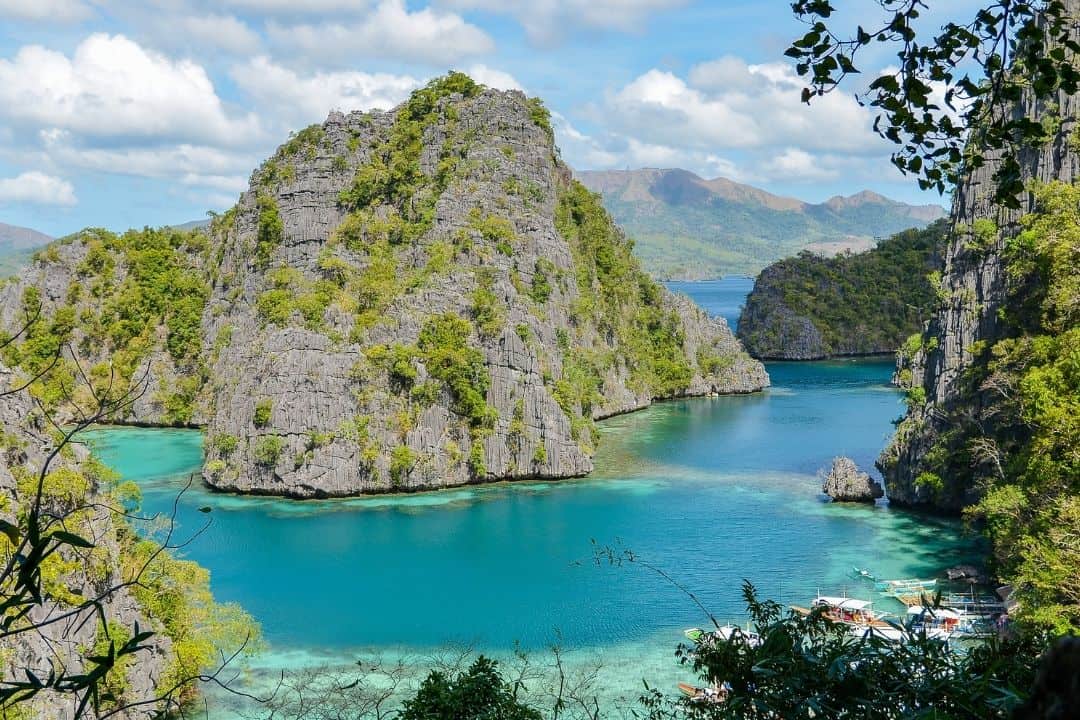This destination guide for diving Cebu Philippines, includes some of my favorite dive sites and dive destinations in the world.
Diving in Cebu and other places in the Philippines can spoil you for diving elsewhere.
The Philippines is in the “Coral Triangle” the area in the world known for its biodiversity.
Destructive practices in the past has lead to the establishment of marine protected zones which has improved reef health and increased the amount of fish.
Biomass (the weight of fish in a given area) is very high in many areas. Accommodations in Cebu range from very simple backpacker hostels to luxury resorts.
Add in great visibility and the possibility of diving almost year round and you have a perfect dive destination.
Any destination guide of the best diving in Cebu Philippines would have to include diving in Mactan, Malapascua Island, and Moalboal Cebu.
You should also visit Oslob, where scuba diving with whale sharks is available year round. The Tañon Strait is a great liveaboard destination.
In the article “The Best 16 Dive Destinations in the Philippines” I included three destinations in Cebu.
This destination guide to diving Cebu will expand on those three destinations and add more information about diving in Cebu.
Get your bucket list out and be ready to add a few more Cebu diving destinations to it.
Where or What is Cebu
The name Cebu can be confusing as it is applied in a number of ways. Locals seem to understand where you are talking about due to context, visitors can be confused.
Cebu Province is made up of Cebu Island and 167 surrounding smaller islands and islets.
It is located in the central portion of the Philippines called Visayas or the Visayas Island Group.
Cebu Island itself is long and narrow, stretching 122 miles (ca. 196 km) from north to south and 20 miles (ca. 32 km) across at its widest point. Cebu City is the capital of the province with a population of about a million people. Metro Cebu consists of 7 cities and has a population of over 3 million.
Tagalog is the official language of the Philippines with about 25% of Filipinos using it as their first language.
The highest usage of Tagalog is in Luzon. Cebuano, also called Bisayan or Visayan, is spoken in the Visayas region of the Philippines and most people in the region consider it their first language and 20% of all Filipinos.
English is also an official language of the Philippines and along with Tagalog taught in schools throughout the country.
English is used in business and many official settings. English speakers will be as able to communicate with others as someone speaking Tagalog.
Diving Mactan Island Philippines
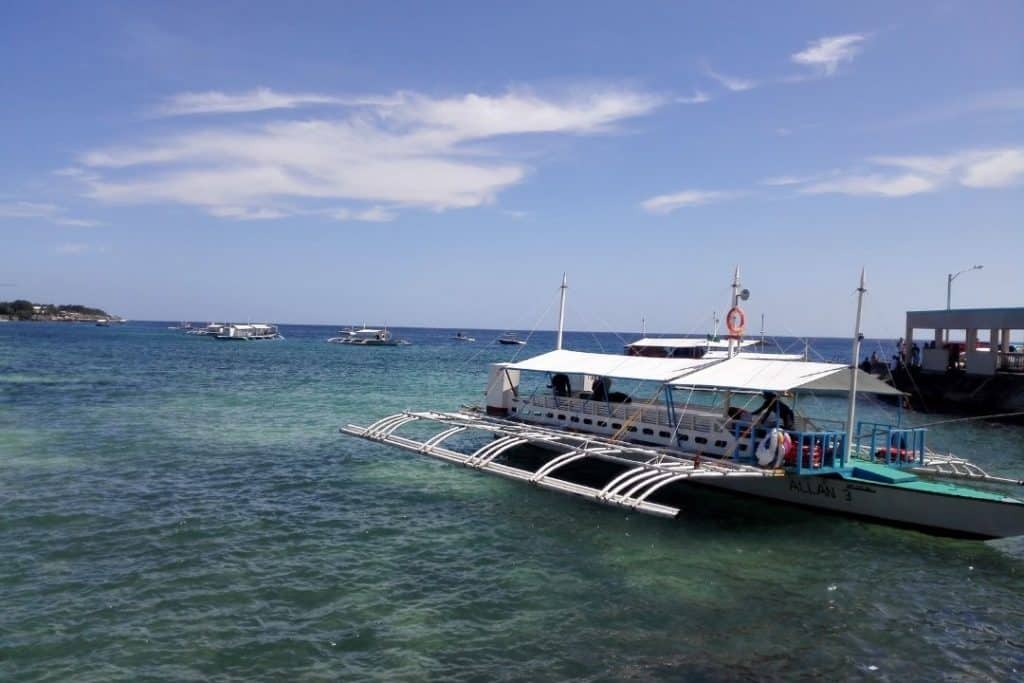
Whether you are looking to become a certified diver or are an advanced technical diver Mactan has exactly what you are looking for in a warm water diving destination.
Mactan Island is the home of Lapu-Lapu City one of the 7 cities that make up Metro Cebu.
Cebu City is to the west connected by two bridges while the Hilutungan Strait is to the east of the island.
Most of the beaches, dive resorts, nearby marine sanctuaries and water sport activities are along the east coast of the island.
For the diver, Mactan has it all, warm waters, outstanding visibility, great reefs, cave diving, gentle drift dives, not so gentle drift dives, deep dives, wreck diving and outstanding marine life.
You have your choice of numerous shore dives, boat dives and dive safaris. A dive safari is often a 3 tank dive trip to a remote location that requires a few hours of travel, a few may even be an overnight trip.
The overnight trips may have you sleep onboard or in local accommodations.
There are over 20 dive operators to choose from with PADI, SSI, GUE, RAID and others represented. The number of dive sites depend on who you talk too, there are dozens.
Some dive operations include dive sites around nearby Olango Island as local diving, while dive centers in the southern part of Mactan Island may include dive sites in the Mactan Reef Flats.
Let’s take a peek at some dive sites/ locations for Mactan diving.
Shangri-La Marine Sanctuary
This six hectares (14.8 acre) marine sanctuary sits off the beach in front of Shangri- La Resort and is the house reef for the resort and Scotty’s Action Sports Network.
Scotty’s is the dive center operator at the resort and marine protected area. This is not your typical house reef.
This is a site you could dive for a week and still be thrilled with every dive.
Speaking from experience here. You can dive from shore or from the pier, while some parts are a short boat ride. As you move away from your entry point, you will find a gently sloped reef starting around 10 feet (ca. 3 meters) and going down to 65 feet (ca. 20 meters).
The reef has been surveyed and found to contain over 160 species of corals and marine life. Near the edge of the sanctuary, The reef becomes a wall that drops to 130 feet (ca. 40 meters) to a sandy bottom.
The slope continues down to 330 feet (ca. 100 meters) and is used for technical dives and technical dive training.
The resort with steward partners Amores Charities, Inc. and Scotty’s Action Sports Network have maintained this sanctuary officially since 2007, starting years before protecting and developing it before it was officially established.
Hilutungan Island Marine Sanctuary and Nalusuan Island Marine Sanctuary
These two dive sites are often dived together. Both offer excellent diving with options for beginner and advanced divers. While they do share many of the same features, they do offer different experiences.
The Cebu Strait separates the Island of Cebu from the Island of Bohol and has a depth of about1,000 feet (ca. 305 meters).
The northern portion of the strait diverts to three channels. The Mactan channel is between Cebu Island and Mactan Island.
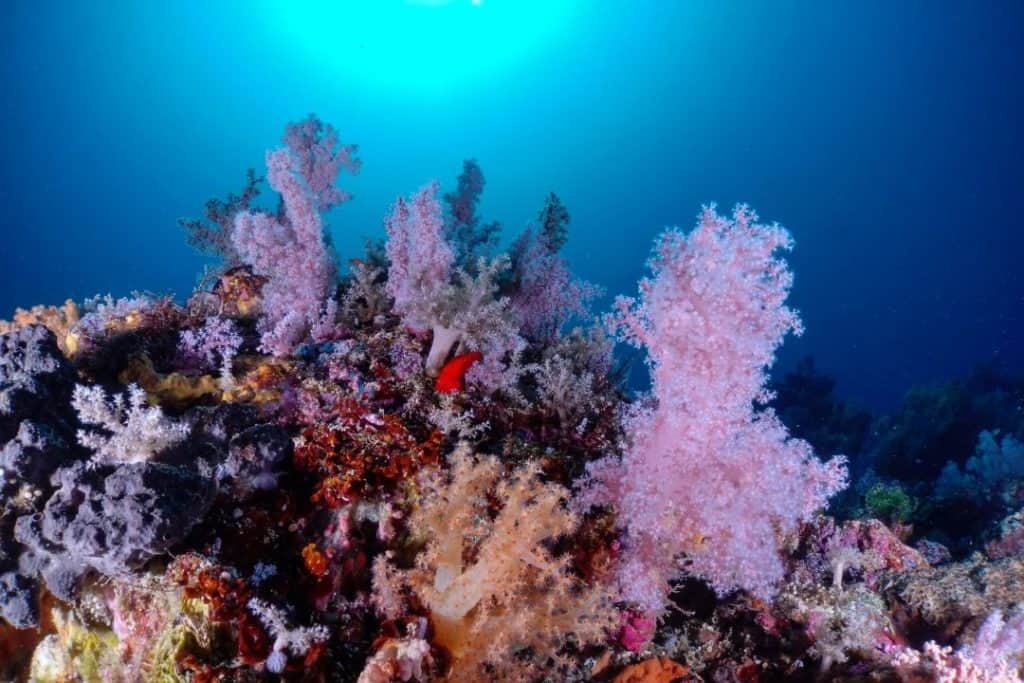
The Hilutangan channel is between Mactan and islands of the Olango island group. The Olango channel is between Olango Island and Bohol.
These channels remain deep and are diverted by islands and shallow reef flats.
Hilutungan Island, also called Gilutongan Island, is on Olango Reef Flat on the Hilutangan channel side. Nalusuan Island is located at the edge of the Olango Reef Flat on the Olango channel side.
Both of these sites are popular island hopping destinations as they are great for swimming, snorkeling and discover dives as well as for certified divers. Both sites offer shallow reefs great for snorkeling and underwater photography.
The reef life is great, one of the best dive sites in the country. You will find that the reefs are different.
The Nalusuan Island site is noted for large flat plate corals and colorful reef fish.
Hilutungan Island has other coral structures and attract larger fish and sea turtles. Both sites also have wall dives and diving adventures that extend beyond recreational limits.
The Hilutungan Island wall is a steep slope, while the Nalusan Island wall is near vertical.
Marigondon Cave
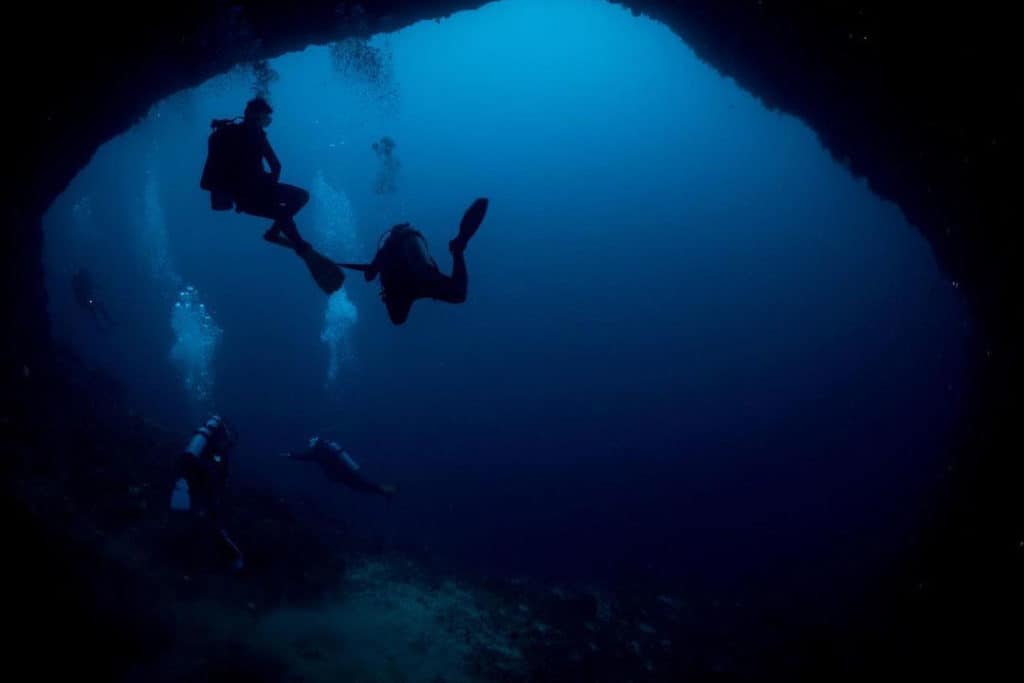
This is one of the most popular dive sites for advanced or deep divers.
Certified cave divers have a number of underwater caves to choose from in the area, however, the Marigondon cave is really a cavern dive.
While both cave and cavern dives are overhead environments, in a cavern dive you can always see the light of your exit.
This is an incredible dive for advanced scuba divers, both in and around the cavern. The entrance to the cavern is along a gorgonian and sea fans covered wall about 100 feet (ca. 30 meters) deep and about 30 feet (ca. 9 meters) by 45 feet (ca. 14 meters) in size.
Marigondon cave reaches back 130 feet (ca. 40 meters) with a sandy bottom and scatter corals around 120 feet (ca. 37 meters).
How much does it Cost to Dive and Stay in Mactan Island
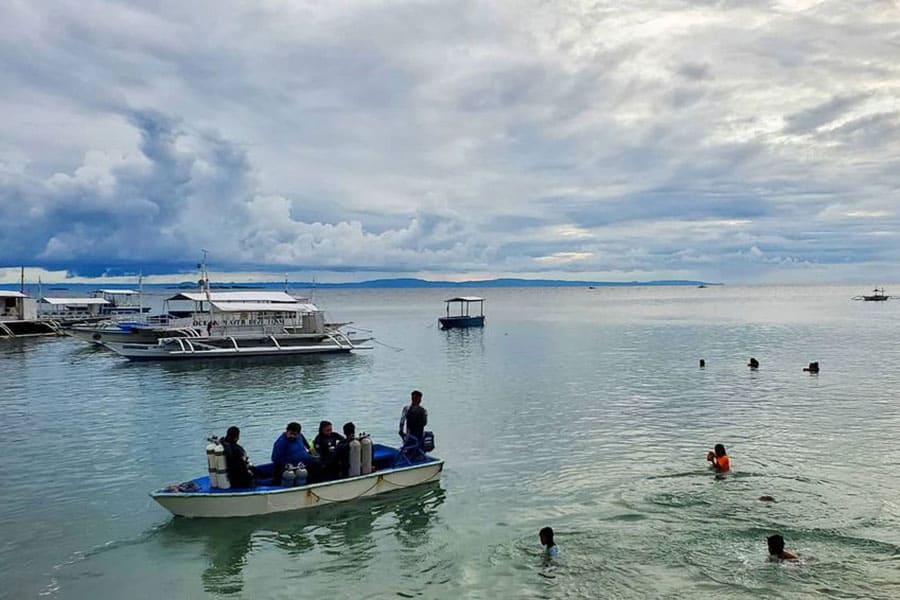
Diving in Cebu is a great value for the international diver. It is compatible with diving in say Thailand and a huge bargain compared to most other dive destinations.
There is some variation in prices and some dive centers offer packages for 10 or more dives and room/diving packages.
You can find shore dives ranging from 750 php to 1,250 php, roughly 15 USD to 25 USD. Night dives and Boat dives for nearby mactan dive sites can range from 1,250 php to 2,800 php, about 25 USD to 55 USD.
There are a few dive centers that offer a 3 tank dive trip that includes water, fruit, snacks, bbq lunch plus dive gear and marine park fees for 2,500 php around 50 USD.
Accommodation also has a wide range of prices. To be a little blunt, the cost of living and wages are not that high in the Philippines.
While Mactan and Cebu are international tourist destinations, it is also a domestic destination.
That gives the visitor a wide range of accommodations to chose from.
The luxury hotel chain Shangri-La has one of the most expensive beachfront properties, the Shangri-La Mactan Resort with rooms from 150 USD a night.
Feel Deep Dive Resort and Sugarsea Inn & Dive shop are both very nice upscale dive resorts and have rooms starting for under 60 USD a night.
If you do not mind being away from the waterfront you can find apartments and hotel rooms as low as 15 USD a night.
My last trip to Mactan was with some friends, we rented a 2 bedroom town house for 20 USD a night.
The Mactan-Cebu International Airport is the gateway to Cebu, and is located on the island.
Many of the hotels and resorts will arrange transportation, or you can take a short taxi ride to your accommodations.
Grab is a ride-share that is available from the airport. A ride from the airport to Shangri-La Mactan Resort would cost around 250 php, about 5 USD, a little more if traffic is heavy around the airport.
Diving Moalboal Cebu
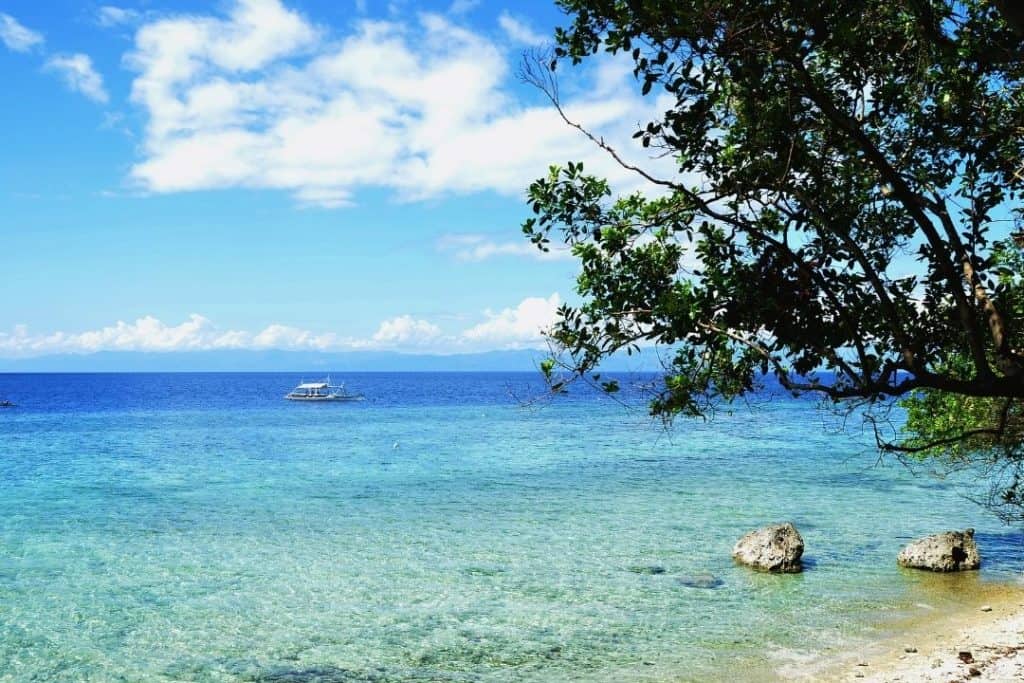
No best dive sites destination guide to Cebu Philippines is complete without including diving in Moalboal.
Moalboal is often called a backpacker and scuba diver paradise.
It is about 2 and a half hours southwest of Cebu City, and is located on the Tañon Strait. The Tañon Strait is around 100 miles (ca 160 km) long and varies from 3 to 17 miles (ca 5 to 27 km) wide.
The strait is over 1,700 feet (ca. 518 m) deep in places with a number of small islands and coral reefs.
The major islands of Cebu and Negros have healthy reefs along the strait as do the many small islands in the strait itself.
The Philippines, being in the famous coral triangle, is known for it’s biodiversity, and this is very apparent in the Tañon Strait.
There 14 species of dolphins and whales in the strait along with many species of sharks and rays.
These are attracted to the abundant reef fish that calls this area home. Moalboal is the heart of this diving.
There are many dive resorts and dive operators in the area providing access to outstanding diving. There are over two dozen dive sites, not counting house reefs. Here are the top 2.
Sardine Run

Do you know what a shoal is? Many experienced divers will jump right in and say a shoal is an area of shallow water surrounded by deep water, like a seamount.
Then what is a shoal of sardines? Another definition of shoal is a large group of fish, similar to a school but not necessary all the same species.
Moalboal is said to have the second largest Sardine Run in the world after the one in South Africa.
The South Africa Sardine Run is a migrator trip for the sardines, divers follow if liveaboards, not so in Moalboal.
Here shoals of sardines numbering in the hundreds of thousands are sighted year-round. Divers can often reach them from shore dives from house reefs, other times by short boat rides.
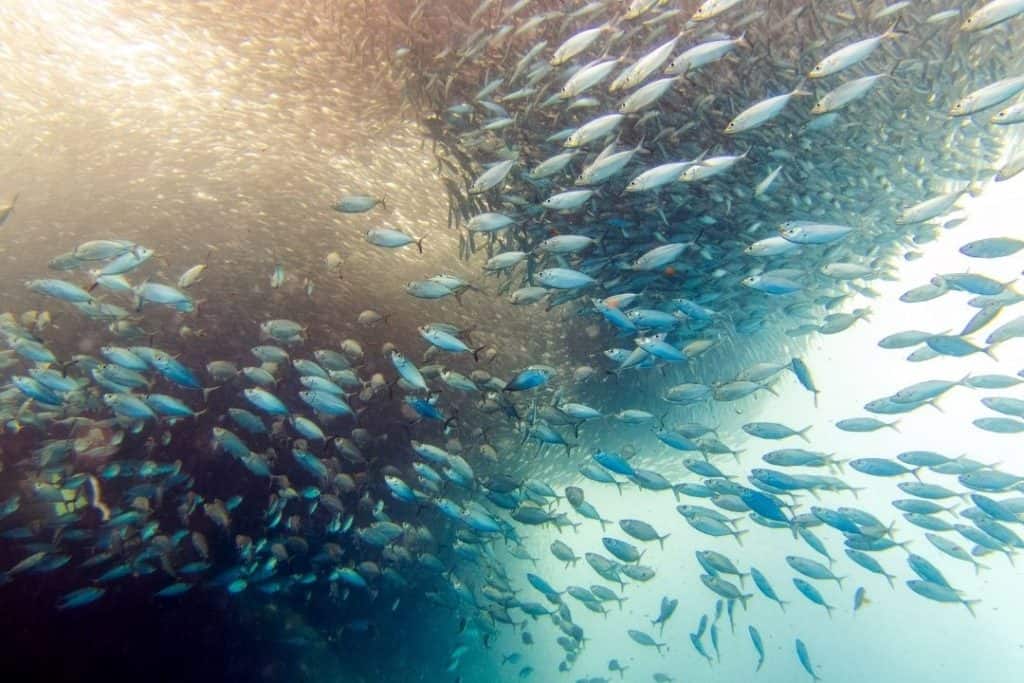
Slowly swim into one of these shoals and the sardines will make room for you and close your path behind you.
Stay back and photograph the memorizing sight or watch predators like grey reef sharks, dolphins, hammerhead sharks and birds have a snack.
Pescador Island

A picture perfect island in the strait, surround by coral and walls.
Each of the four sides of this island offer a different experience and a number of dive sites. The east side of the island has a shallow reef that extends out from the island mostly between 16 feet (ca. 5 meters) to 24 feet (ca. 7 meters) deep. It then forms a wall that drops to 175 feet (ca. 53 meters) before dropping deeper.
The north and part of the west have only a narrow reef before it becomes a deep wall steep.
The Cathedral in northwest side is cave dive that most consider to be a cavern dive. There are a few entrances from the wall into the cave with additional light from some chimneys.
The island is said to have over 450 species of hard coral. Barracuda, tuna and white tipped reef shark are often seen along the walls.
How much does it Cost to Dive and Stay Moalboal
Diving rates are similar to Mactan, with 1100 php about 21 USD for a shore dive and 1,300 php about 25 USD for a boat dive. Most sites have a fee of 100 php about 2 USD for a conservation fund.
Most of the accommodations in Moalboal are on the inexpensive side with an average price below 30 USD a night and stays as low as 10 USD.
Dive resorts such as Teobas Resort and Diving Center and Cherepakha Dive Center have rooms for around 25 USD. The leading dive resorts are higher such as The Blue Orchid Resort around 60 USD and Kasai Village Dive Resort around 100 USD.
Thresher Sharks and Diving Malapascua Island
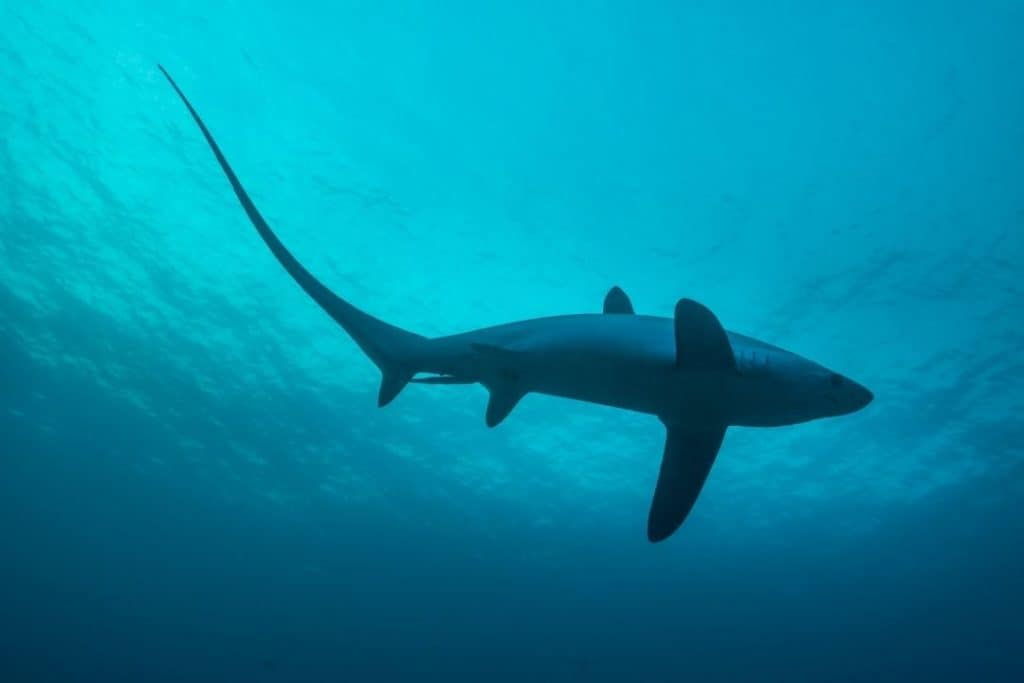
Divers first come to Malapascua to dive with thresher sharks. But thresher shark dives are not the main reason they return.
They return because the island offers divers much more than one dive site.
Divers will encounter interesting marine life, outstanding reefs a few wrecks and can even dive under another island.
Malapascua Island is a small island located a few miles offshore of Daanbantayan, Northern Cebu.
The island is only 1.6 miles (2.57 kilometers) long by .6 miles (ca. 1 kilometer) wide with 8 small hamlets spread across the island.
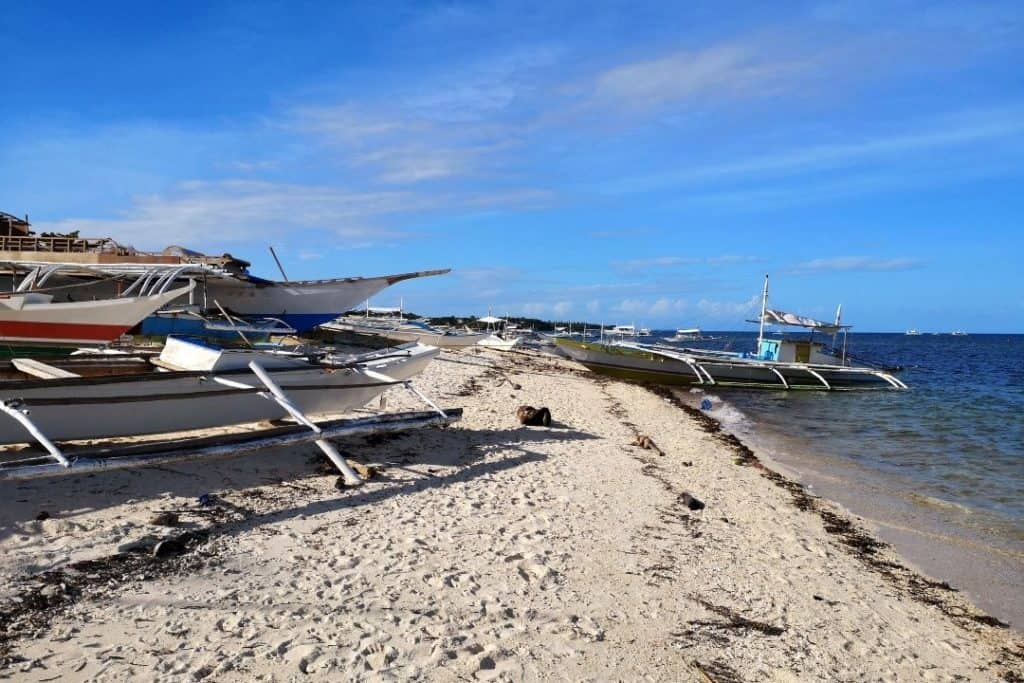
The main “town” is Bounty Beach which has most of the resorts and restaurants, and the only paved road which is about a quarter mile long. Dirt roads and trails will lead you to other parts of the island.
If you are not walking, expect to ride on the back of a motorcycle.
The lifestyle here is simple and laid back, the beaches are great and the diving world-class.
There are about 15 dive centers, most of them small with simple accommodations, however, there are a few larger operations and upscale resorts.
There are 13 dive sites that ring the island plus 3 shoal dive sites and 2 islands.
Slightly further away is Gato Island and the MV Doña Marilyn wreck.
Let’s get wet.
Monad Shoal
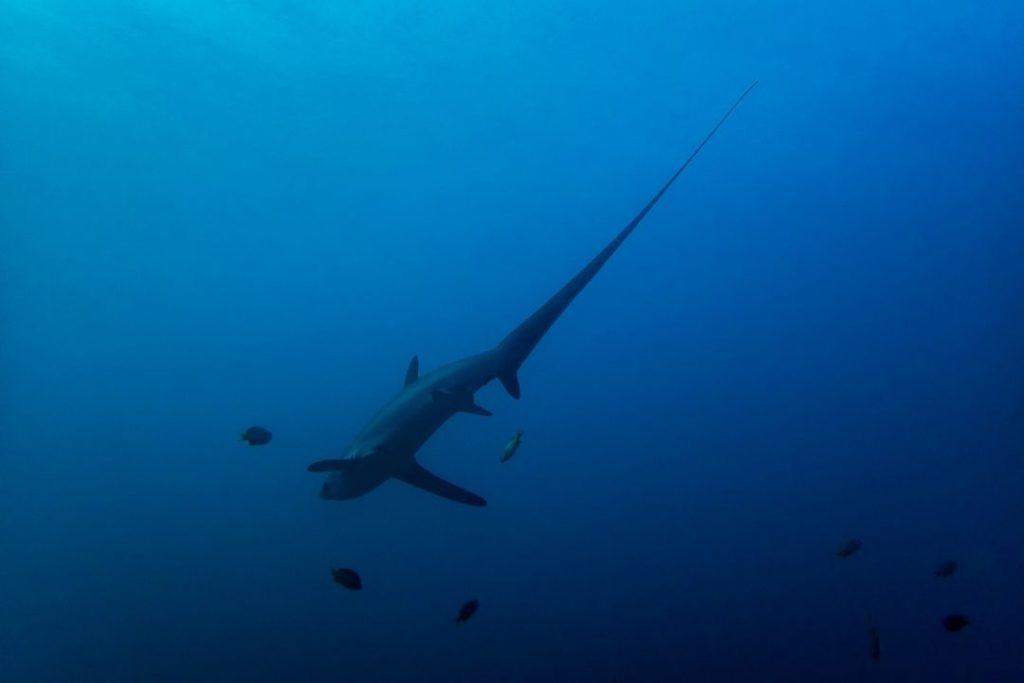
This is the site that launched Malapascua to become an international diving destination.
The Monad Shoal dive spot is an underwater seamount rising from water more than 800 feet (ca. 244 meters) deep to as close as 50 feet (ca. 15 m) from the surface. It is the only location in the world that divers can have a high expectation of experiencing thresher sharks.
There are three types of Thresher Sharks, Pelagic Thresher, Common Thresher, and Bigeye Thresher, The Pelagic Thresher is the smallest with an average length of 10 feet (ca. 3 meters), half of that being the tail.
These are the one found on Monad Shoal with an occasional sighting of a Common Thresher.
Pelagic Threshers are normally solitary animals roaming large sections of the ocean alone 450 feet (ca. 137 meters) to 800 feet (ca. 244 meters) from the surface, rising to feed at times. Things are different here.
Starting near sunrise, numerous thresher sharks ascend from the deep to the shoal. Here, they approach cleaning stations where small fish remove parasites from their skin and teeth.
When the process is done the shark moves off and another one will often take its place. There are five moored sites on the north end of the shoal, each within site of a cleaning station.
Divers either hover or knee in the sand to watch the action. Some dive operators will have the divers slowly swim.
A shark 10 foot long can look menacing, but threshers are shy and may hurry away if they see you.
Sunrise is the busiest time, but sharks will appear for a few hours. Manta rays and hammerheads make seasonal appearances as well. (Kimud Shoal is another dive site noted for hammerheads)
Diving is year round and for advance divers, Nitrox is recommended. Blue Nomads has an underwater chart showing the shoal and a few additional dive sites.
Gato Island
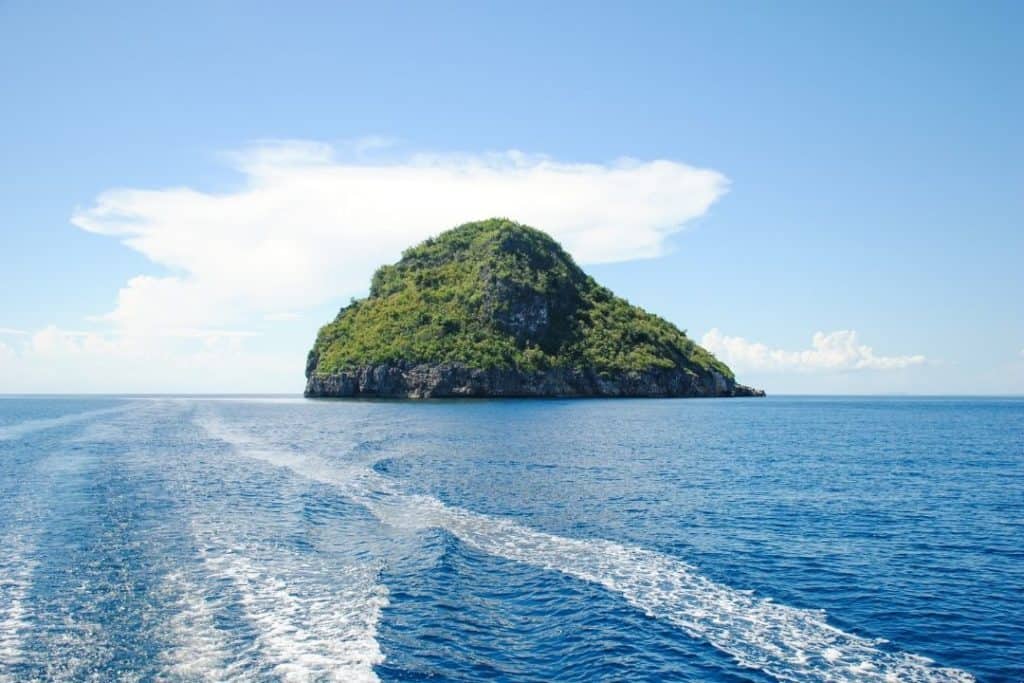
Gato Island is a 45-minute boat ride from most of the dive centers on Malapascua Island. Most dive center will schedule one or two trips a week to the island.
While there is great diving around Malapascua, the trip is well worth the boat ride. Gato Island is another marine sanctuary noted for the soft and hard coral reefs, great visibility, and healthy marine life.
The dive sites are great for all level of divers with sites from 30 feet (ca. 9 meters) to 75 feet (ca. 23 meters). It you love sharks, this is a great location to see white tip reef sharks and bamboo sharks.
Underwater macro photographers will find seahorses, nudibranchs, Spanish dancers and shrimp.
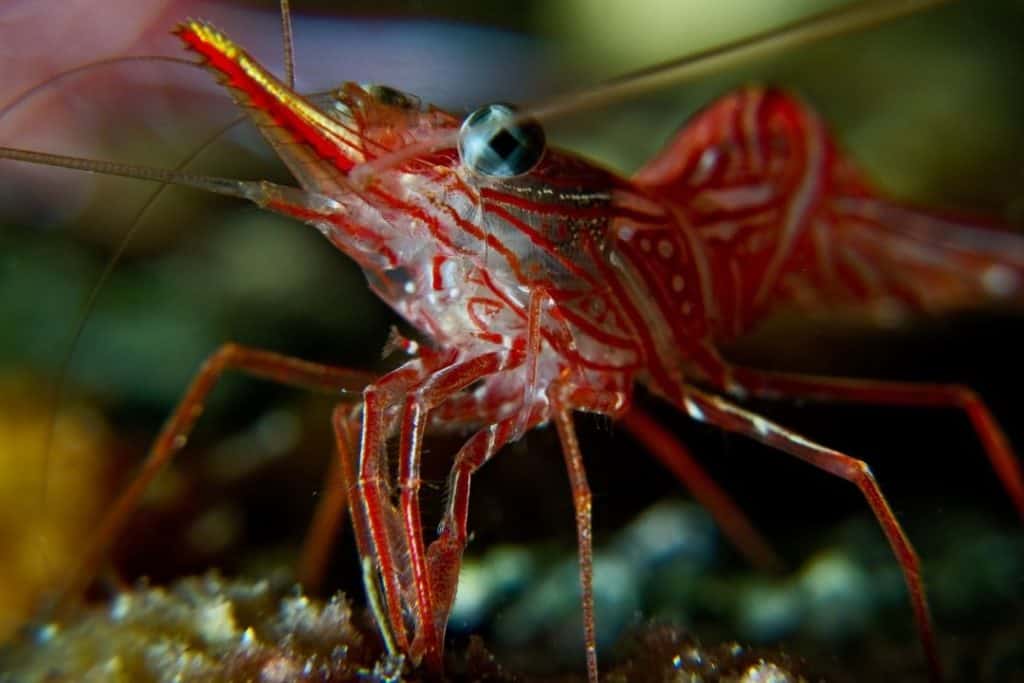
Not to mention a myriad of soft and hard corals, other marine species like banded sea snakes, frogfish, porcupine fish, cuttlefish, and scorpion fish for underwater photographers.
Want a little adventure? Advanced divers will find the “cave” a nice dive. The “Cave” is a tunnel under the island.
Starting about 35 feet (ca. 11 meters) deep you will swim about 95 feet (ca. 29 meters) to the opposite side. Sharks like to rest in the cave as well.
Lighthouse Reef

The lighthouse reef is located, you guessed it, near the lighthouse. It is a shallow dive about 30 feet (ca. 9 meters) deep. The coral gardens are wonderful and has abundant small reef fish.
Bring your camera for this site, and you can also photograph blue ring octopus, cuttlefish and squid. Most diver do two dives at this site.
An afternoon dive exploring the reef and a small ship wreck, followed by a twilight dive. One of the most colorful reef fish is the Mandarin Fish, and this site has many of them.
At sunset, the male Mandarin Fish will start a mating dance to attract any interested females.
Words alone can not describe the colorful, vibrant dance. It will be a display you will always remember.
How Much Does it Cost to Dive and Stay in Malapascua Island
The cost of diving in Malapascua runs about the same as in Mactan.
The average price per dive will be around 1,500 php about 30 USD. Trips to Gato Island may be slightly more to cover the cost of the extra fuel. Also, some dive sites have a conservation fee per dive, these will range from 2 to 5 USD.
Most of the places to stay on the island are simple accommodations, with a some mid-range and a few upscale.
The Little Mermaid Dive Resort is one of the most established and oldest dive resorts on the island.
You can often get rooms here for less than 30 USD a night. AABANA Beach & Watersport Resort has private rooms for half that price. And there are some hostels around 10 USD. The Little Mermaid Beachfront Dive Resort by Cocotel is the most expensive resort with rooms starting at around 100 USD a night.
While searching online for accommodations for Malapascua it best to look at a map view while searching.
The island is part of Daanbantayan a town which is on Cebu Island. Search results may include places not on Malapascua Island or exclude those who see the town as the address.
Whale Shark Diving in Oslob, Cebu Philippines
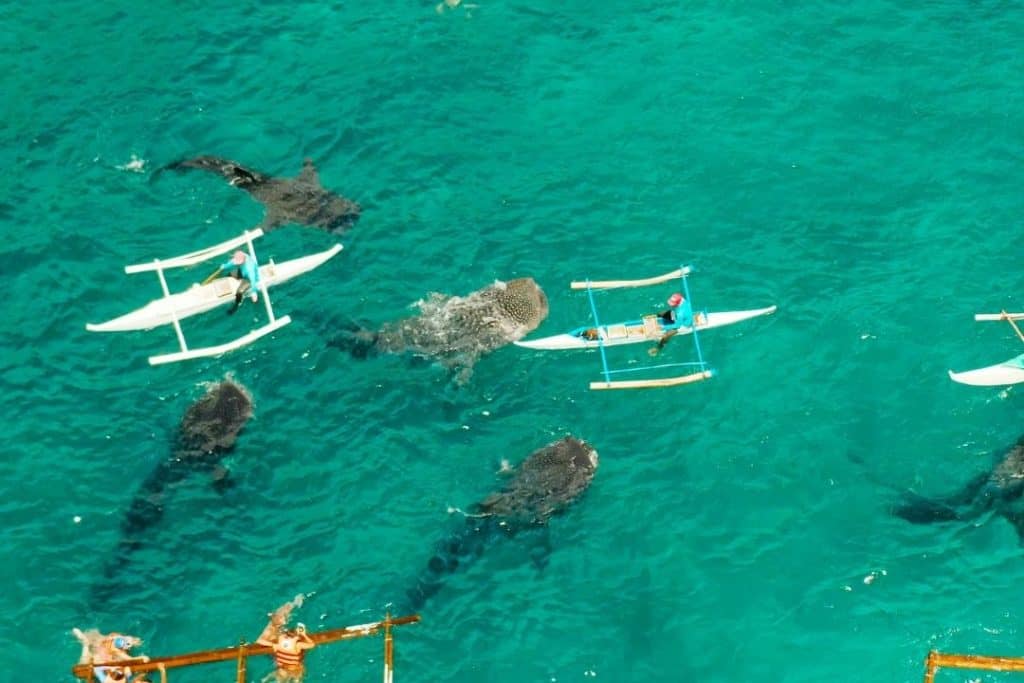
Diving with a whale shark is a lifelong dream for many divers, and many divers have that dream come true diving Oslob.
Diving with the world’s largest fish, one that is often compared in size to a school bus, is not something you will forget.
For the last decade, Tan-awan Oslob has earned the reputation as one of the best places to swim with whale sharks. The location does have its critics.
In the past, fisherman used to threw small shrimp into the water to lure whale sharks away from their fishing boats, so the whale sharks would not chase their catch away.
Once tourist became aware of this, they hired fisherman to do this to lure the whale sharks close for snorkeling or diving.
In 2011, the fisherman organized, created a whale shark sanctuary, and started a daily feeding, attracting the whale sharks to their hand paddled boats and waiting tourist.
Today, as many as 15 outrigger boats will wait for the whale sharks to react to the feeding.
Critics say doing so changes the animal’s behavior. Some studies show that only less than 5% of the whale sharks are permanent “residents”. Also, that over 30% of all identified whale sharks around the Philippines have been sighted here.
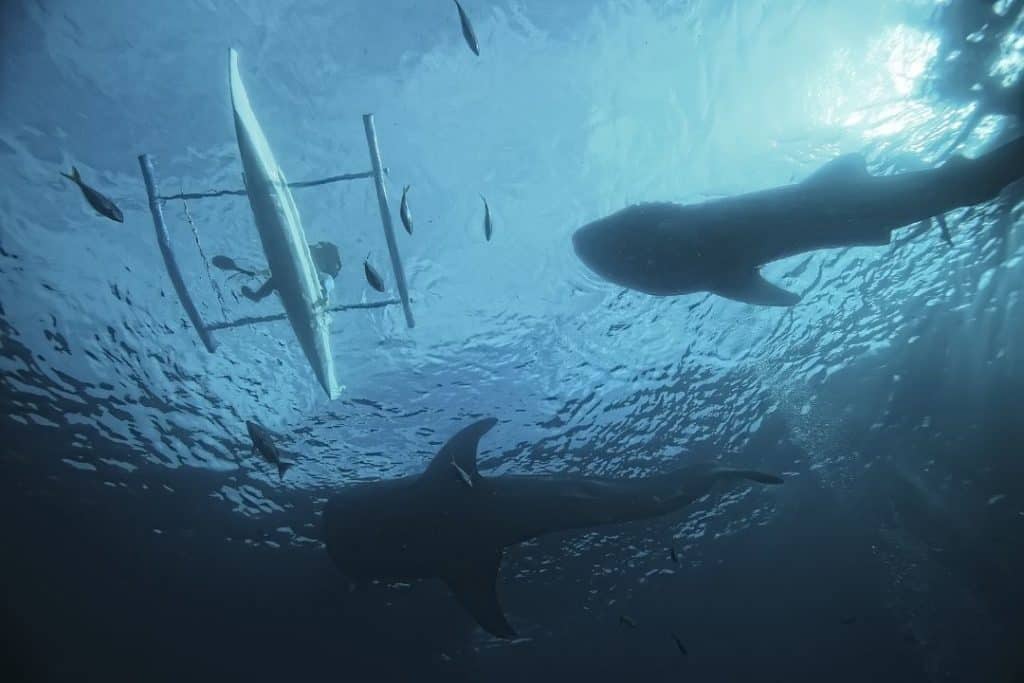
Divers can approach the whale sharks as a shore dive or from dive boats outside the sanctuary diving site.
Many of the divers that dive here do so as a side trip from diving Mactan or Moaboal. Dive centers in those locations offer organize day trips to dive with the whale sharks.
However, you should consider Oslob as a dive destination in its own right.
Osbol is located at the southern tip of Cebu Island near the entrance of the Tañon Strait and Dumaguete .
The dive centers in Oslob dive some the same dive sites as the dive centers in Dumaguete, as well as sites dived in the strait. Sumilon Island and Caceres Reef located near to Oslob offers many dive sites.
How Much Does it Cost to Dive and Stay Oslob
The diving prices in Oslob are in the same range as other locations in Cebu. However, there is an environmental fee charged for diving in the whale shark sanctuary that can be as much as 30 USD.
Accommodations also run in the same range, maybe slightly lower on average. The average price per night is below 30 USD.
The ARA dive resort have very nice rooms for around 25 USD. A simple room at Guilly’s Place is around 10USD.
Billy’s Resort may be perfect if you have a large group. There 3-bedroom apartment will sleep 16 for around 70 USD a night.
Liveaboard Diving in Cebu
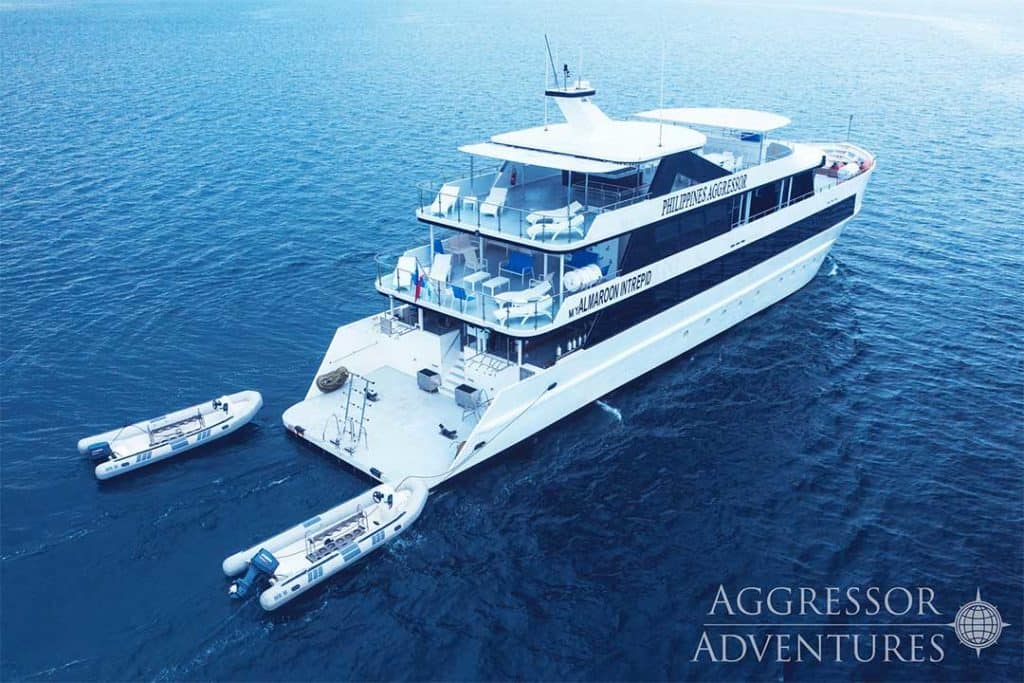
A few years ago the Philippine liveaboard industry was limited to Tubbataha Reef.
The industry has expanded and 15 liveaboards sail the Tubbataha Reef scuba diving sites for it’s 3 month season. Ten of those remain in the Philippines and sail at least part of the year around Cebu.
The Tañon Strait is a popular destination as is Malapascua. Diving the Cebu strait and Bohol is also popular.
Some the leading liveboards sail Cebu include the Philippines Aggressor, the Infiniti Liveaboard, the Discovery Palawan, and the Philippines Siren Sailboat.
Travel to Cebu Philippines
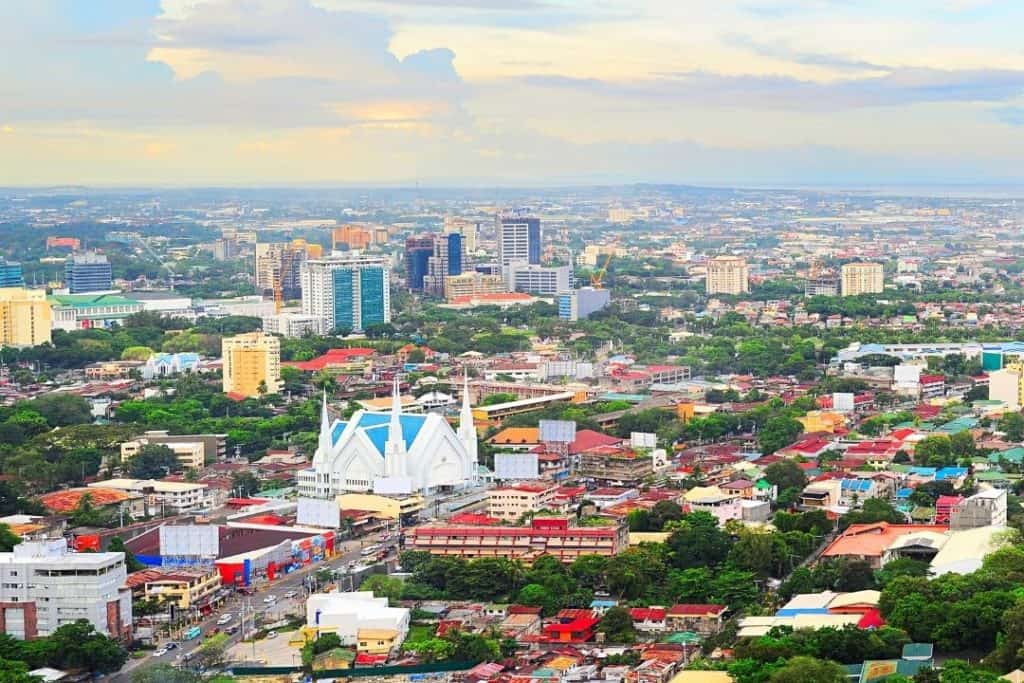
Metro Cebu is the hub for travel to and in Cebu Philippines. Mactan-Cebu International is the Philippines’ second busiest airport. International travelers can fly direct to Cebu on 17 different international carriers.
Those arriving in Manila will find over 220 flights a week from the Manila airport to Cebu and another 35 from the airport in Clark.
Domestic flights from 9 airlines will take you to the small airports in the region and to major destinations around the country.
The Metro area has two major bus stations. The north station for destinations to the north of the city such as Malapascua.
The south station for areas south of the city including Moalboal. You should be able to travel anywhere in Cebu by bus for less than 8 USD.
You can also connect to most of the nearby provinces by ferry, that leave from Cebu city.
Are You Ready to Dive Cebu?
I have dived in many warm water destinations and a few colder water destinations across the world.
Many of my most loved dives were in the Philippines, and I am sure that in the years to come there will be more.
Is Cebu Philippines on your bucket list? Have you aready been there? Let us know in the comments section.

